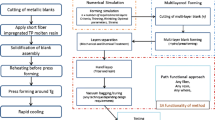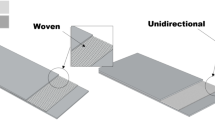Abstract
Lightweight, hybrid parts are extensively used in the manufacturing of modern aerospace or automobile structures like fiber metal laminates (FMLs) to replace the monolithic metallic parts. Presently, smaller and complex-shaped FML parts are made by applying the stamp-forming techniques. However, due to limited strain of the composite fibers, such techniques are unfit for forming complex profile laminated parts. This study focuses on the use of hydro-mechanical deep drawing (HMDD) for the three layers simultaneous forming of the metallic blanks to fabricate a hemispherical structure which will then be used to make a FML part. Orthogonal test strategy is formulated to investigate the influence of variables such as cavity/pre-bulging pressures, pre-bulging height, and die-binder gap to optimize the forming conditions. FE-based experimental study is done to research the thickness distribution and spring back of the formed multilayer structure. Results show that the research is sufficient in predicting these attributes and can provide a basis to understand the fundamental phenomenon for three-layered, simultaneously formed structures. Hybrid parts fabricated by using multilayer forming can expand the application areas of FMLs.
Similar content being viewed by others
References
Asundi A, Choi AYN (1997) Fiber metal laminates: an advanced material for future aircraft. J Mater Process Technol 63:384–394
Sinmazcelik T, Avcu E, Bora MO, Coban O (2011) A review: fibre metal laminates, background, bonding types and applied test methods. Mater Des 32:3671–3685
Park SY, Choi WJ, Choi HS (2010) A comparative study on the properties of GLARE laminates cured by autoclave and autoclave consolidation followed by oven postcuring. Int J Adv Manuf Technol 49:605–613
Kumar KV, Safiullah M, Ahmad ANK (2013) Root cause analysis of heating rate deviations in autoclave curing of CFRP structures. Int J Innov Res Stud 2(5):369–378
Dmitriev O, Mischenko S (2011) Optimization of curing cycles for thick-wall products of the polymeric composite materials. INTECH Open Access Publisher ISBN 978-953-307-150-3, pp. 141-160
Thomas MM, Joseph B, Kardos JL (1997) Experimental characterization of autoclave-cured glass-epoxy composite laminates: cure cycle effects upon thickness, void content, and related phenomena. Polym Compos 18(3):283–299
Mosse L, Compston P, Cantwell WJ, Cardew-Hall M, Kalyanasundaram S (2005) The effect of process temperature on the formability of polypropylene based fibre–metal laminates. Compos A: Appl Sci Manuf 36(8):1158–1166
Mosse L, Compston P, Cantwell WJ, Cardew-Hall M, Kalyanasundaram S (2006) Stamp forming of polypropylene based fibre–metal laminates: the effect of process variables on formability. J Mater Process Technol 172(2):163–168
Kalyanasundaram S, DharMalingam S, Venkatesan S, Sexton A (2013) Effect of process parameters during forming of self reinforced–PP based fiber metal laminate. Compos Struct 97:332–337
Gresham J, Cantwell W, Cardew-Hall MJ, Compston P, Kalyanasundaram S (2006) Drawing behaviour of metal–composite sandwich structures. Compos Struct 75(1):305–312
Lang LH, Danckert J, Nielsen KB (2005) Multi-layer sheet hydroforming: experimental and numerical investigation into the very thin layer in the middle. J Mater Process Technol 170:524–535
Tzou GY, Huang MN (2003) Analytical modified model of the cold bond rolling of unbounded double-layers sheet considering hybrid friction. J Mater Process Technol 140:622–627
Zafar R, Lang L, Zhang R (2014) Experimental and numerical evaluation of multilayer sheet forming process parameters for light weight structures using innovative methodology. Int J Mater Form 1-13
Tseng HC, Hung CH, Huang CC (2010) An analysis of the formability of aluminum/copper clad metals with different thicknesses by the finite element method and experiment. Int J Adv Manuf Technol 49:1029–1036
Atrian A, Fereshteh-Saniee F (2013) Deep drawing process of steel/brass laminated sheets. Compos Part B 47:75–81
Hino R, Goto Y, Yoshida F (2003) Springback of sheet metal laminates in draw-bending. J Mater Process Technol 139(1):341–347
Kim HS, Koç M (2008) Numerical investigations on springback characteristics of aluminum sheet metal alloys in warm forming conditions. J Mater Process Technol 204(1):370–383
Mohammadi SV, Parsa MH, Aghchai AJ (2011) Effect of the thickness distribution and setting condition on springback in multi-layer sheet bending. International Journal of Engineering, Sci Technol 3(4)
Author information
Authors and Affiliations
Corresponding author
Rights and permissions
About this article
Cite this article
Zhang, R., Lang, L., Zafar, R. et al. Investigation into thinning and spring back of multilayer metal forming using hydro-mechanical deep drawing (HMDD) for lightweight parts. Int J Adv Manuf Technol 82, 817–826 (2016). https://doi.org/10.1007/s00170-015-7415-5
Received:
Accepted:
Published:
Issue Date:
DOI: https://doi.org/10.1007/s00170-015-7415-5




